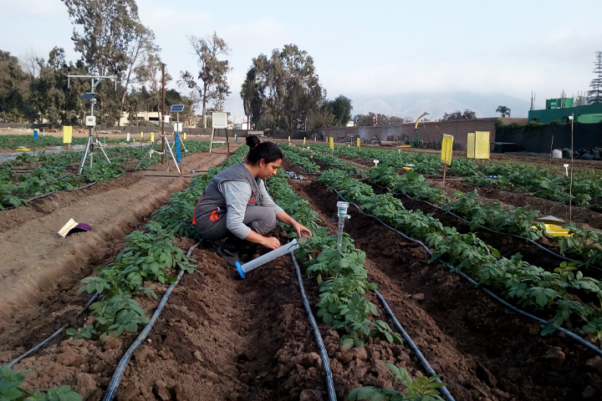
Agriculture uses 70% of global fresh water consumption and farmer demand for water will grow significantly in the next two decades as they increase production by 60% to feed the global population of 9.6 billion expected by 2050. Given the stress of climate change, optimizing water use in agriculture should be a key component of the food system transformation needed to produce more food while staying within the planet’s boundaries.
Research on using thermal imagery to optimize water use in potato recently published in Agronomy provides useful information and tools for more water-efficient agriculture that can contribute to that goal. In a series of field studies in Peru, scientists from the International Potato Center (CIP) and partner institutions used thermal imagery to measure the water stress of potato plants and balance irrigation timing with crop stress thresholds to produce good harvests with less water.
“Irrigation is vital for food production in many areas of the world, but water mismanagement wastes a precious resource and can lead to land degradation, salinization and poor crop productivity,” said Javier Rinza, a researcher at CIP and lead author of the study.
Rinza and colleagues developed a unique model integrating key indicators such as water use, yield, economic benefit, and environmental impact that could be used to implement high-tech irrigation that reduces water use without sacrificing yields. The results create a foundation for future water management strategies that optimize yield and environmental outcomes in a changing climate.
Adapting agriculture to climate change
Potato is the world’s third most important food crop and has great potential for increasing food production in the face of climate change. The energy it produces relative to water use is higher than staple crops such as maize and rice, and its cultivation produces lower greenhouse gas emissions than rice, for instance.
To optimize water use, the research team used cameras with infrared sensors to monitor potato plants’ foliage temperature and apply a crop water stress index to determine when they needed to be watered. By timing crop irrigation to balance water use and plant stress, the researchers were able to optimize potato yield and water use.

The researchers used a heat- and drought-tolerant potato cultivar called UNICA – increasingly popular in Latin America, Africa and Asia – and compared both furrow irrigation and drip irrigation strategies. As expected, furrow irrigation used more water than drip irrigation, however, by timing irrigation to only use water when the plants became stressed, they demonstrated that water use can significantly be reduced under both furrow and drip irrigation systems.
The team applied the Cool Farm Tool potato model to monitor key agronomic and environmental indicators and compared the data to production costs to determine the benefit-cost ratio for different irrigation schemes. Fresh tuber yield and irrigation water use were incorporated into a model that considers overall sustainability.
Balancing water use with yield and environmental outcomes

While potato yields were lower under higher stress thresholds, production costs were similar across different stress thresholds, though consistently higher for drip irrigation than for furrow irrigation. Overall, total emissions were highest for furrow irrigation under the highest stress threshold, but comparable to drip irrigation under moderate stress.
A key aspect of this study is the use of an integrated index to combine all indicators for a holistic assessment of technologies under different scenarios. By considering more than just yield, the model integrates economic benefit and environmental indicators such as water use and carbon footprint. This holistic assessment found that furrow irrigation under medium stress conditions did not significantly reduce yield, had lower production costs and comparable total carbon emissions relative to drip irrigation.
“The integrated index we propose can be used for a holistic assessment of any technology. In addition to water management, it can be used in breeding, seed system management or other agronomic activities,” said co-author David Ramírez, leader of CIP’s Crop Ecophysiology and Modelling Laboratory.
While Ramírez and colleagues used a portable photosynthesis system and handheld thermal cameras in this study, he noted that the approach can be scaled up using remote sensing technology, such as drone- or satellite-based thermal imagery, to estimate stress thresholds in crops and inform water management decisions.
“We plan to use this technology in combination with conservation agriculture practices in trials at the CIP experimental station in Lima as part of ongoing research on the sustainable intensification of agriculture in arid zones, under the CGIAR Research Initiative on Excellence in Agronomy” said Ramírez. “Our long-term objective is to optimize irrigation water use on a regional scale and improve water management in a way that balances agronomic, economic, and environmental aspects to mitigate the impact of climate change and protect precious fresh-water resources.”
Read the article here
This research was funded by CGIAR Trust Fund contributors and the Programa Nacional de Innovación Agraria (PNIA), Peru
Blog by Abby Cuttriss and David Dudenhoefer
